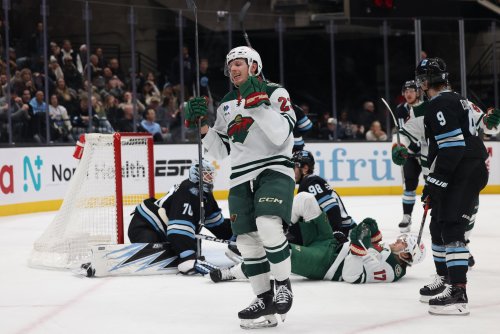
The Minnesota Wild currently have the top ranked penalty kill in the entire NHL. They are successfully killing penalties at a rate of 96.3%. This is a full 15 percentage points better than the current league average of 81.3%. We’ve seen the Wild lead the league in the penalty kill in recent history with the team finishing the 2014-15 season with a penalty kill rate of 86.3%, so the success the Wild are enjoying on the PK isn’t without precedent. Of course, last season was a different story as the Wild finished 27th overall with a rate of 77.9%. So why the big change in success in the early stages of this season?
The Wild’s penalty kill, like most penalty kills that find high levels of success at the NHL-level, is enjoying strong goaltending. Shorthanded goalie performances and penalty kill rates are a bit of a chicken-and-the-egg situation as a well-executed PK helps a goalie make saves, but a goalie making saves instills confidence in a team’s shorthanded play. Nevertheless, a goalie on a tear definitely boosts his team’s penalty kill performance. It’s still early into the season, so Devan Dubnyk’s hot streak is definitely skewing the Wild’s shorthanded numbers.
The Wild’s penalty kill has been aggressive so far this season. The team is making it difficult for opponents to move through the neutral zone, denying the other team time to make plays, and getting sticks in the passing lanes. Preventing the opposing team from easily setting up in your zone reduces the time they have to generate scoring chances. The danger of aggressive penalty killing is in chasing the puck around the zone, always one pass behind the play. So far, the Wild have done a stellar job striking the balance between aggressive play and not getting sucked into a fruitless puck hunt.
Rare is the team that cannot get off any shots during an entire game’s worth of power play opportunities (although last season’s Wild seemed determined to unlock the formula). Not taking penalties is a helpful way to constrain your opponent’s opportunities, but the Wild are middle-of-the-road by that measure. Where they are performing well is in only surrendering lower quality chances and keeping sight lines clear for Dubnyk. I’ll caveat this by saying this is entirely based on my eye test, but so far this season the Wild seem far better at forcing opposing teams to resort to shots from the point that Dubnyk is able to track. The Wild are keeping the slot and the circles mostly clear of passing and shots which makes Dubnyk’s job much easier. Perhaps the PK system is designed to deliberately allow shots from the point or perhaps Scott Stevens has the Wild focused on locking down the ice nearer to the goal, but whatever the reason, the result is the Wild are not giving up grade A chances when shorthanded.
The most apparent and critical difference between the penalty kill this season as compared to last season: different personnel on the penalty kill. Under Mike Yeo, penalty kill duties were primarily relegated to third and fourth line players. Bruce Boudreau, however, leans heavily on his top 6 forwards to man the penalty kill. Take a look at the top 12 players for penalty kill time on ice from last season and this season.
Early injuries to Jared Spurgeon, Marco Scandella, Zach Parise, and Erik Haula mean the current season leaders are not an exactly accurate representation of Boudreau’s preferred deployment of players on the penalty kill. Nevertheless, the difference between the two seasons is stark. Mikko Koivu, one of the best defensive forwards in the entire league, was the fourth-most used forward in shorthanded situations last season. This season he leads all the forwards. Eric Staal, Mikael Granlund, Jason Pominville, and Zach Parise are all far more talented than Ryan Carter, Jarret Stoll, or Chris Porter. Last season, the latter group saw far more ice time on the penalty kill than the former. In fact, their presence on the team hinged on ability to play effectively on the penalty kill. They weren’t and, as a result, Minnesota was near the bottom of the league in shorthanded situations. Boudreau’s use of his most talented forwards on the penalty kill has, on the contrary, yielded league-leading results.
So far this season, Zac Dalpe, Teemu Pulkkinen, and Nino Niederreiter haven’t played one second on the penalty kill. Those three have spent much of this nascent season on the third and fourth lines. While many of us at Hockey Wilderness would argue that Niederreiter should have a role on the penalty kill, it does reveal that Boudreau prefers to not trust his lower line forwards on the penalty kill.
The Wild is thriving so far in shorthanded situations and it appears that this is thanks to the brand new approach brought to it by new head coach Bruce Boudreau. Minnesota’s success shouldn’t be too surprising. Many of the players on the team have been part of a first overall penalty kill unit two seasons ago. Last season, it was Boudreau’s Anaheim Ducks that lead the league. The combination of personnel and coaching should see the Wild continue to dominate while shorthanded.
Think you could write a story like this? Hockey Wilderness wants you to develop your voice, find an audience, and we'll pay you to do it. Just fill out this form.





.thumb.jpg.a9b35df58693aa7a574a96bc7e6aac74.jpg)


Recommended Comments
There are no comments to display.
Join the conversation
You can post now and register later. If you have an account, sign in now to post with your account.
Note: Your post will require moderator approval before it will be visible.